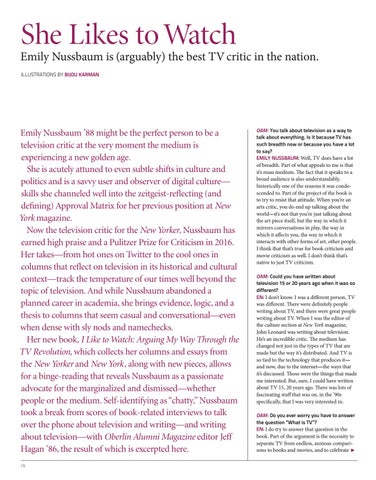She Likes to Watch
Emily Nussbaum is (arguably) the best TV critic in the nation. ILLUSTRATIONS BY BIJOU KARMAN
Emily Nussbaum ’88 might be the perfect person to be a television critic at the very moment the medium is experiencing a new golden age. She is acutely attuned to even subtle shifts in culture and politics and is a savvy user and observer of digital culture— skills she channeled well into the zeitgeist-reflecting (and defining) Approval Matrix for her previous position at New York magazine. Now the television critic for the New Yorker, Nussbaum has earned high praise and a Pulitzer Prize for Criticism in 2016. Her takes—from hot ones on Twitter to the cool ones in columns that reflect on television in its historical and cultural context—track the temperature of our times well beyond the topic of television. And while Nussbaum abandoned a planned career in academia, she brings evidence, logic, and a thesis to columns that seem casual and conversational—even when dense with sly nods and namechecks. Her new book, I Like to Watch: Arguing My Way Through the TV Revolution, which collects her columns and essays from the New Yorker and New York, along with new pieces, allows for a binge-reading that reveals Nussbaum as a passionate advocate for the marginalized and dismissed—whether people or the medium. Self-identifying as “chatty,” Nussbaum took a break from scores of book-related interviews to talk over the phone about television and writing—and writing about television—with Oberlin Alumni Magazine editor Jeff Hagan ’86, the result of which is excerpted here. 26
OAM : You talk about television as a way to talk about everything. Is it because TV has such breadth now or because you have a lot to say? EMILY NUSSBAUM: Well, TV does have a lot
of breadth. Part of what appeals to me is that it’s mass medium. The fact that it speaks to a broad audience is also understandably, historically one of the reasons it was condescended to. Part of the project of the book is to try to resist that attitude. When you’re an arts critic, you do end up talking about the world—it’s not that you’re just talking about the art piece itself, but the way in which it mirrors conversations in play, the way in which it affects you, the way in which it interacts with other forms of art, other people. I think that that’s true for book criticism and movie criticism as well. I don’t think that’s native to just TV criticism. OAM : Could you have written about television 15 or 20 years ago when it was so different? EN: I don’t know. I was a different person, TV
was different. There were definitely people writing about TV, and there were great people writing about TV. When I was the editor of the culture section at New York magazine, John Leonard was writing about television. He’s an incredible critic. The medium has changed not just in the types of TV that are made but the way it’s distributed. And TV is so tied to the technology that produces it— and now, due to the internet—the ways that it’s discussed. Those were the things that made me interested. But, sure, I could have written about TV 15, 20 years ago. There was lots of fascinating stuff that was on, in the ’90s specifically, that I was very interested in.
OAM : Do you ever worry you have to answer the question “What is TV”? EN: I do try to answer that question in the
book. Part of the argument is the necessity to separate TV from endless, anxious comparisons to books and movies, and to celebrate
